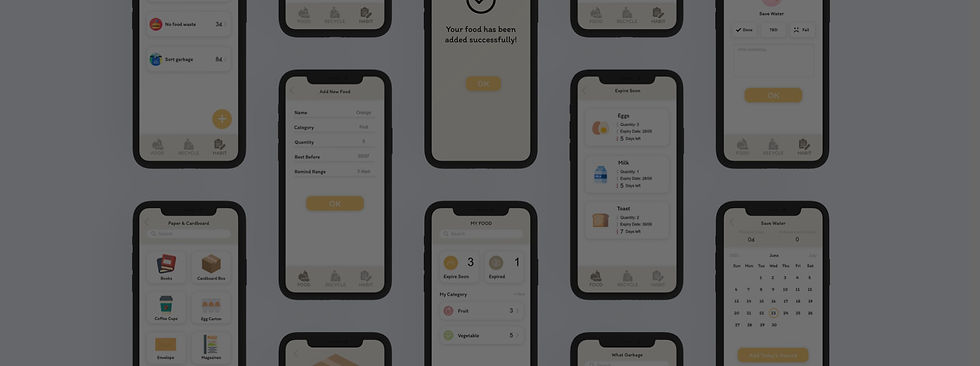
My Life
Role - Researcher, UI designer, UX designer
My Life is a sustainable app which helps users reduce food waste, understand recycling knowledge and build sustainable habits.
The goal of the project was to make users reduce waste and live a more sustainable lifestyle.
The challenge was to design three functions around sustainability aiming at reducing waste.
Problem Space
Based on the problem of waste in sustainable development, I have summarized the following three issues.
-
Food Waste: People like to keep buying food but they easily ignore the food they bought before which can cause great waste of food.
-
Lack of recycling knowledge: It might cause confusion on garbage sorting, which leads the waste of manpower and material resources.
-
Lack of sustainable habits: People’s consciousness and potential thinking about sustainable lifestyle need to be improved.
INTERVIEW ANALYSIS
To understand participants' experience about food waste, recycling knowledge and sustainable habits, I used show & tell and card sorting as my research method.
From the interview I knew that the participants had experience on food waste and knew the reason of food waste. Also, with basic recycling knowledge, the participants still felt confused about garbage sorting of specific items. Furthermore, the participants had the idea to be sustainable, but can't find a proper way to build sustainable habits.
Basically, their knowledge basically comes from their experience in daily life, but they may not have a detailed understanding of that and lack of systematic approach.

The wireframes were created for mobile with three features. Each feature of the app was showed in separate row of the sketch. It allowed me to set elements appropriately and gain the overall visual structure.
I developed three functions based on the three problems discusses above - a reminder and recorder of food expire date, a collection of recycling knowledge for users to search and check, and a sustainable habit tracker.
USER FLOW DIAGRAMS

Diagrams of user flow visualized the app features and provided a systematic structure of the operation process.
TESTING
Usability Test for Paper Prototype
The participants were asked for adding a new sustainable habit in the app. The result of paper prototype test was positive that the participant basically had no confusion about the function and process. Thus I remained these elements the same.
PERSONA

Through research and interview, I was able to build the persona targeting at the problem space and develop the app.
MENTAL MODELS

I created three mental models for each task domain to help me understand the pattern.
EMPATHY MAP

PAIN/GAIN MAP
Pains
-
Don't have a proper way to solve the problem of food waste.
-
It’s not convenient to find the key information about recycling needed directly.
-
Could easily forget the habits that was trying to form even have taken the notes in phone, couldn't remember without seeing the contents.
Gains
-
Have the intention to reduce food waste and know the main problem on food waste.
-
Have the basic knowledge about recycling garbage and will search online if get confused.
-
Have consciousness and good start about building habits to be sustainable.
-
Have experience of second-hand buying which is also a sustainable thinking.
FEATURED EXPERIENCE MAP

RESEARCH
SOLUTIONS
WIREFRAMES


CONCLUSION
I learned the entire process of designing an app including investigation and test. During researching of solutions I also gained a deeper understanding of sustainability. The app still has development space such as a more usable Axure structure for database of the recycling knowledge.












